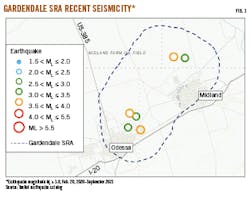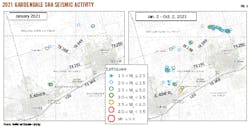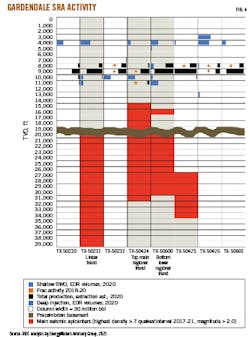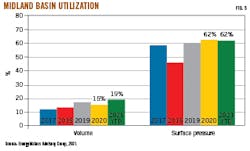West Texas seismic activity constrains saltwater well injection
On Sept. 24, 2021, the Railroad Commission of Texas (RRC) limited saltwater disposal (SWD) injection activity to 10,000 b/d in permitted SWD wells in Midland basin’s Gardendale Seismic Response Area (SRA) based on increasing seismic activity.1 Further, the RRC prohibited injection into SWD wells drilled but not yet in service and will not approve permits for new SWD within the Gardendale SRA. These restrictions will cut Midland basin’s permitted disposal capacity by around 50% in shallow and moderately deep (< 8,000 ft) wells, and by 90% in deep injection wells. Most shallow-to-moderately-deep wells will not be affected by the new restrictions, but half of the deep SWD wells will be constrained.
Furthermore, in October 2021 the RRC established the Northern Culberson-Reeves (NCR) SRA in northern Culberson and Reeves Counties, Tex., just south of New Mexico, due to increased seismic events in the region.2 Fifteen earthquakes ≥ 4.0 local magnitude (ML) have occurred since Jan. 1, 2020, with six events between Sept. 3, 2021 and Oct. 3, 2021. As in the Gardendale SRA, the RRC declared that SWD well injection is a likely contributor to this seismicity and restricted injection rates by an average of 54% (ranging from 25% to 88%, depending upon the well). These proposed restrictions will significantly curtail current injection. Nine wells will be directly affected by the proposed restrictions, and currently inactive wells will remain inactive.
RRC injection-well permitting
Under RRC’s 2014 Title 16 economic regulation rules, Sections §3.9 and §3.46, the RRC can modify, suspend, or terminate a permit “if injection is likely to be or determined to be causing seismic activity.”3 Seismic restrictions exist throughout the Permian for SWD wells operating within 9.01 km, or 5.6 miles of an earthquake.4
In the 2014 commenting period regarding these sections, five seismologists jointly filed comments which stated that “injection fluids may stay well confined in the injection interval, but their pressure perturbation induced by the injections fluids can have farther reaching effects.”5 They noted that these perturbations can change local stress regimes resulting in earthquakes along preexisting fault structures. The seismologists recommended annual bottom hole shut in pressures measurement and reporting to determine if injected fluids are having far reaching effects on subsurface stress. At the time the RRC generally agreed with the comments but declined to require annual reporting of bottom-hole shut in pressures for all disposal wells.
Permit applications for SWD must obtain records for historic seismic events within 100 sq miles (9.08 km radius) of a proposed disposal well. Other information such as logs, geologic cross-sections, pressure-front boundary calculations, and structural maps may be required in cases in which the well location may indicate risk that fluids will not be confined to the injection interval.
Operators must monitor and record surface injection pressure and injection rate of each disposal well on at least a monthly basis and report results annually. The commission can require more frequent monitoring and reporting if conditions suggest that fluids are not being contained within the presubscribed injection area.
Earthquake frequency
Rystad Energy analyzed seismic activity in key US oil producing regions and determined that the number of noticeable (ML > 2) earthquakes in Texas, Oklahoma, Louisiana, and New Mexico has been increasing since 2017.6 In Midland basin, TexNet data show that tremors above 2 ML increased by a factor of five from 2019 to 2020 (Table 1). There were no seismic events greater than 3.5 ML in 2019, but there were four such events in both 2020 and 2021. As of Oct. 4, 2021, TexNet started manually reviewing all earthquakes 2 ML or greater due to increased seismic activity in the Permian basin.
Gardendale SRA
Between Feb. 1, 2020, and Sept. 30, 2021, six earthquakes 3.5 ML or greater occurred in the Gardendale SRA spanning Midland basin from northeast Ector County to southwest Martin County, including parts of Midland and Andrews counties (Fig. 1). This activity included a 3.7 ML earthquake in southwestern Martin County, about 8 miles northwest of Midland, on Sept. 7, 2021, and two 3.6 ML earthquakes northeast of Odessa in February 2020 and May 2021.
The RRC determined that SWD contributed to the seismic activity and requested that 30 operators in the Gardendale SRA reduce SWD activity to 10,000 b/d in 76 permitted SWD wells in the area (46 currently active) and refrain from injecting into SWD wells drilled but not yet in service. The RRC will not approve permits for new SWD within the Gardendale SRA.
Operators are also requested to measure daily injection volumes and pressures including historic daily injection data since November 2019, if available, and report to the RRC monthly. These mandates are expected to last about a year.
According to EnergyMakers Advisory Group, 29 active shallow and moderate SWD wells (< 8,000 ft TVD) in the Gardendale SRA inject an estimated 32 million bbl/year with an allowable 140 million bbl/year of incremental growth before reaching volume limits.7-8 The new restriction will limit growth to 73 million bbl/yr, about a 50% reduction. The new 10,000 b/d maximum injection restriction, however, affects only one of the wells. Most injection wells historically operate near 3,500 b/d.
Seventeen deep SWD wells were injecting an estimated 46 million b/d in 2021 with an allowable 130 million bbl/year incremental growth before reaching volume limits. From data available to June 2021, six deep wells injected more than 10,000 b/d. Half of these deep wells will likely have their volumes curtailed. The new restriction will limit incremental injection growth to 16.1 million bbl/yr, nearly a 90% curtailment.
SWD-earthquake correlation
Fig. 2 shows injection and seismic response in the Gardendale SRA per 100 sq mile gridblock.9 The SRA is outlined by the black dotted line. Daily injection rate per block is indicated by the intensity of blue shading. Individual well injection volume/day is illustrated by yellow circles, and seismic activity is illustrated by red circles up to magnitude 3.4, and by brown circles for magnitude 3.5 and above.
Seismic activity is not generally in areas of concentrated 2020 disposal and high injection rates. The largest earthquake swarm recorded from 2017-present occupies a regional trend southwest of the SRA, and a smaller swarm consists of a linear trend in the northwest section. The linear trend is near two large-volume injection wells, but the regional trend is away from most disposal wells and high injection rates. Fig. 3 shows seismicity in 2021 where activity was heavy along the linear trend, starting around April.
Earthquake correlations to injection, production, and depth ranges from EnergyMakers are shown in Fig. 4. The column labels reference gridblocks in Fig. 2. The linear seismic trend is dominant in TX-50231, which had 7.8-million bbl deep (10,000 - 11,000 ft) injection and 29-million bbl extracted oil and water. Nearby block TX-50232, however, experienced no seismic activity but had larger deep injection volumes (8.7 million bbl), about half the total extracted fluids, and more fracturing treatments. It did not, however, have shallow water injection.
The regional trend in TX-50424 and TX-50600 experienced 27 million bbl deep well injection about 7,000-8,000 ft above the Precambrian basement and 95 million bbl extracted oil and water about 11,000 ft above the Precambrian basement. Combined shallow water injection volumes were about the same as TX-50231.
In both the linear and regional trends, extracted fluid volumes were about three times the amount of deep injection volumes. Although substantial volumes of fluids were injected in shallower zones, these were 11,000 to 16,000 ft away from recorded epicenters. The data show no clear correlations between seismicity and injection (shallow or deep), fracturing treatments, or extraction.
Surface pressure limitations
RRC injection permits (statewide rule §3.9 and §3.46) require that “injected fluids remain confined to the authorized injection/disposal interval. The technical review of the proposed injection pressure verifies that the injection pressure does not exceed the formation fracture gradient and that the existing casing cement is adequate to ensure that injected fluids are confined to the proposed injection zone.”
The permitted surface pressure limits are the lower of either the pressure requested in the application or 0.5 psi/ft of depth to the top of the injection-disposal interval (unless a fracture pressure step-rate test supports a higher pressure).
Shallow-moderate SWD wellhead pressures in the Gardendale SRA have gradually increased to 62% maximum allowable surface pressures (Fig. 5). Even with the new injection volume restrictions, EnergyMakers expects that SWD operators will be surface-pressure limited before hitting maximum allowable volumes. Surface-pressure readings in 2021 indicate that volumetric utilization will be about 31-40% by the time maximum allowable surface pressures are attained.
NCR SRA
The RRC established the NCR SRA to coordinate action with industry to reduce the seismic hazard in the SRA. The RRC identified 45 active SWD wells in the NCR SRA currently injecting 683,346 b/d total (Table 2). Operators of active wells had allowable permitted daily volumes of about 2.2 million b/d, representing nearly three times the current aggregate injection volume. Incremental injection volumes were therefore about 1.5 million b/d, but the new proposed restrictions reduce this to 237,000 b/d.
Unlike blanket Gardendale SRA restriction below 10,000 b/d, proposed NCR SRA injection restrictions range from 10,000 b/d to 30,000 b/d, depending upon the well. Currently, nine wells are injecting above the new restriction proposals and will have to be curtailed. The proposed restrictions are designed to reduce earthquakes to a maximum 3.5 ML within 18 months of implementation.
References
- RRC Oil and Gas Division, “Notice to oil and gas operators: Gardendale Seismic Response action,” Sept. 24, 2021. https://www.rrc.texas.gov/media/4ryp5kqr/nto-gardendale-seismic-response-action_9-22-2021.pdf
- RRC Seismicity Response. https://www.rrc.texas.gov/oil-and-gas/publications-and-notices/manuals/injection-disposal-well-manual/summary-of-standards-and-procedures/seismicity-review/seismicity-response/
- Texas Administrative Code, Title 16, Economic regulation, Part 1, Railroad Commission of Texas, Chapter 3. Oil and Gas Division, Rule §3.9 and §3.46, Nov. 17, 2014. https://texreg.sos.state.tx.us/public/readtac$ext.ViewTAC?tac_view=4&ti=16&pt=1&ch=3&rl=Y
- McFarland, J., “Texas Railroad Commission Adopts Rules Aimed at Earthquakes,” Oil and Gas Lawyer Blog, Feb 2, 2015. https://www.oilandgaslawyerblog.com/texas-railroad-commission-adop-1/
- Texas Administrative Code, Title 16, Economic regulation, Part 1, Railroad Commission of Texas, Chapter 3. Oil and Gas Division, Rule §3.9, §3.46, TRD-201405013, Oct. 28, 2014. https://www.oilandgaslawyerblog.com/files/2015/02/rrc-earthquake-rule.pdf
- “Treating the US oil industry’s dark water: As earthquakes increase, billions needed to switch course, Rystad Energy press release, June 10, 2021. https://www.rystadenergy.com/newsevents/news/press-releases/treating-the-us-oil-industrys-dark-water-as-earthquakes-increase-billions-needed-to-switch-course/
- Capper, L., “Part III Deep SWD Performance: Seismic Response Area in Midland – How Much Will It Impact the Oil Biz, Really?” LinkedIn, Oct. 13, 2021. https://www.linkedin.com/pulse/seismic-response-area-midland-how-much-impact-oil-biz-laura-capper-1e/?trackingId=2OdNWuPZo4vbJ3sjEv9i8w%3D%3D
- Capper, L., “Seismic Response Area in Midland – How much will it Impact the Oil Biz, Really?” LinkedIn, Oct. 8, 2021. https://www.linkedin.com/pulse/seismic-response-area-midland-how-much-impact-oil-biz-laura-capper/?trackingId=tMcEks%2FJRC28kRpSmWUNqA%3D%3D
- Capper, L., “Seismic Response Area in Midland – Part I: is it warranted?” LinkedIn, Oct. 6, 2021. https://www.linkedin.com/pulse/seismic-response-area-midlandpart-i-warranted-laura-capper/?trackingId=ltqlI%2B8RG46iD1lwhY6Vhg%3D%3
About the Author
Alex Procyk
Upstream Editor
Alex Procyk is Upstream Editor at Oil & Gas Journal. He has also served as a principal technical professional at Halliburton and as a completion engineer at ConocoPhillips. He holds a BS in chemistry (1987) from Kent State University and a PhD in chemistry (1992) from Carnegie Mellon University. He is a member of the Society of Petroleum Engineers (SPE).







